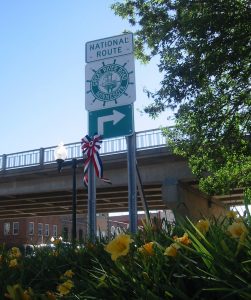One of the most memorable trips on the Great River Road will take you to where it all begins. The headwaters of the Mississippi River can be found in Minnesota, in a small glacial lake called Lake Itasca. The Great River Road travels 575 miles through Minnesota, so there’s a lot of country to explore. The route will take you through impressive northern forests, past the homes of American icons and through rich farmland, charming river towns and vibrant urban centers. You’ll encounter 10 Interpretive Centers – pay them a visit to learn about the fascinating history and heritage of this region.
Here an overview of the Great River Road through Minnesota.
Mississippi Headwaters – Itasca State Park to Bemidji (30 miles): Discover the river’s humble source in Itasca State Park, Minnesota’s oldest state park. The park covers 32,000 acres and it’s a wild place; hear the call of the loon and watch bald eagles soar above the majestic virgin pines along Wilderness Drive. Be sure to stop by the Jacob Brower Visitor Center. Visit Bemidji – first city on the Mississippi – and be sure to capture a photo memory with legendary lumberjack Paul Bunyan and his faithful pal, Babe the Blue Ox. It’s a perfect spot for a selfie!
Mississippi Northwoods – Bemidji to Grand Rapids (100 miles): This is a wild and beautiful drive. You’ll follow the river past a series of iconin Minneota Lakes: Bemidji, Cass, Winnibigoshish and Pokegema. There’s plenty of culture and heritages to explore as well–discover the stories of the Leech Lake Band of Ojibwe and its rich heritage. Learn the history of the lumberjack. Visit Grand Rapids to tour the paper mill, Forest History Center and Judy Garland’s birthplace.
Mississippi Crossings – Grand Rapids to Little Falls (145 miles): This is a land of travelers; by river, rail and road, people of this region have traveled the Mississippi for centuries. Today it plays host to thousands of vacationers each year who bike, golf, fish, bird or simply seek respite. Come to play and to explore the historical routes inspired by the river. One popular attraction is the Charles A. Lindbergh Historic Site in Little Falls.
Scenic Mississippi – Little Falls to Elk River (92 miles): Wild and Scenic River is the designation given to this pristine section of Minnesota’s Mississippi. The river here is ideal for canoeing, picnicking, fishing and scenic biking. Remarkable main street architecture, historic museums, lovely parks, magnificent gardens and scenic rural farmland provide a backdrop for a relaxing river experience.
Metro Mississippi – Elk River to Hastings (75 miles): Abundant parkland and trails invite you to the riverfront renaissance taking place in both Minneapolis and Saint Paul. Enjoy theater, major sports venues, museums, concerts, headline entertainment and shopping. You’ll also encounter thoughtfully preserved riverfront parks, historic sites, and the falls of St. Anthony. For a good overview of the river, stop by the Mississippi River Visitor Center in Saint Paul.
Mississippi Bluffs – Hastings to Iowa Border (140 miles): Bring binoculars to bluff country because the river vistas are remarkable and the wildlife viewing – especially birding – is some of the best in the country. This is eagle country and the National Eagle Center is a good place to learn about these majestic creatures. Follow the river through more than a dozen charming river towns complete with historic main streets, riverboats, unique shopping, museums and warm hospitality.










